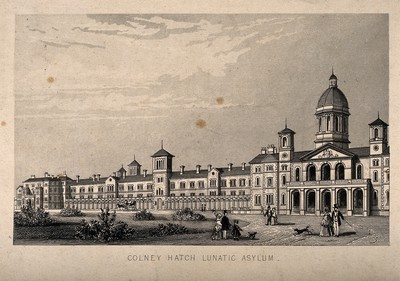Colney Hatch Lunatic Asylum
Colney Hatch Lunatic Asylum, later known as Friern Hospital, was a notable psychiatric hospital located in what is now the London Borough of Barnet. It was one of the largest and most advanced psychiatric institutions of its time when it opened in 1851. The asylum was designed following the principles of the 19th-century asylum movement, which emphasized moral treatment and the therapeutic benefits of architecture and landscape. Its construction was a response to the overcrowded conditions in existing London asylums and was part of a broader Victorian era expansion of mental health facilities.
History[edit | edit source]
The foundation of Colney Hatch Lunatic Asylum was laid out by the Metropolitan Commissioners in Lunacy to alleviate the overcrowding in other London asylums. The design, by architect Samuel Daukes, featured a long corridor system that allowed for segregation of patients by gender and illness severity. The asylum was initially built to house 1,250 patients, but its capacity was frequently exceeded due to the growing demand for mental health care in the 19th and early 20th centuries.
Throughout its history, Colney Hatch was at the forefront of several innovations in psychiatric care, but it also faced criticism and controversy, particularly concerning patient treatment and the conditions within the institution. In the early 20th century, the asylum underwent several name changes, eventually becoming Friern Hospital in 1937.
Architecture and Layout[edit | edit source]
The architecture of Colney Hatch Lunatic Asylum was emblematic of the Victorian era's approach to asylum design. Its elaborate Gothic Revival style was intended to convey a sense of order and moral upliftment. The layout included extensive grounds, which were used for therapeutic gardening and recreation, reflecting the era's belief in the healing power of nature and outdoor activities.
Treatment and Innovations[edit | edit source]
In line with the moral treatment philosophy, Colney Hatch provided various occupational therapies, including farming, crafts, and other work intended to engage patients and provide a sense of purpose. The asylum was also among the first to experiment with emerging treatments for mental illness, such as electrotherapy. However, like many institutions of its time, it also used methods now considered inhumane, such as restraint and isolation.
Closure and Legacy[edit | edit source]
Friern Hospital was closed in 1993 as part of the Care in the Community initiative, which aimed to treat mental health patients in less institutional settings. The site has since been redeveloped for residential use, though some of the original buildings have been preserved.
The history of Colney Hatch Lunatic Asylum is a reflection of the evolving understanding of mental health and the treatment of mental illness. It serves as a reminder of the past practices in psychiatric care and the importance of ongoing reform and improvement in mental health services.
See Also[edit | edit source]
Search WikiMD
Ad.Tired of being Overweight? Try W8MD's physician weight loss program.
Semaglutide (Ozempic / Wegovy and Tirzepatide (Mounjaro / Zepbound) available.
Advertise on WikiMD
|
WikiMD's Wellness Encyclopedia |
| Let Food Be Thy Medicine Medicine Thy Food - Hippocrates |
Translate this page: - East Asian
中文,
日本,
한국어,
South Asian
हिन्दी,
தமிழ்,
తెలుగు,
Urdu,
ಕನ್ನಡ,
Southeast Asian
Indonesian,
Vietnamese,
Thai,
မြန်မာဘာသာ,
বাংলা
European
español,
Deutsch,
français,
Greek,
português do Brasil,
polski,
română,
русский,
Nederlands,
norsk,
svenska,
suomi,
Italian
Middle Eastern & African
عربى,
Turkish,
Persian,
Hebrew,
Afrikaans,
isiZulu,
Kiswahili,
Other
Bulgarian,
Hungarian,
Czech,
Swedish,
മലയാളം,
मराठी,
ਪੰਜਾਬੀ,
ગુજરાતી,
Portuguese,
Ukrainian
Medical Disclaimer: WikiMD is not a substitute for professional medical advice. The information on WikiMD is provided as an information resource only, may be incorrect, outdated or misleading, and is not to be used or relied on for any diagnostic or treatment purposes. Please consult your health care provider before making any healthcare decisions or for guidance about a specific medical condition. WikiMD expressly disclaims responsibility, and shall have no liability, for any damages, loss, injury, or liability whatsoever suffered as a result of your reliance on the information contained in this site. By visiting this site you agree to the foregoing terms and conditions, which may from time to time be changed or supplemented by WikiMD. If you do not agree to the foregoing terms and conditions, you should not enter or use this site. See full disclaimer.
Credits:Most images are courtesy of Wikimedia commons, and templates Wikipedia, licensed under CC BY SA or similar.
Contributors: Prab R. Tumpati, MD

